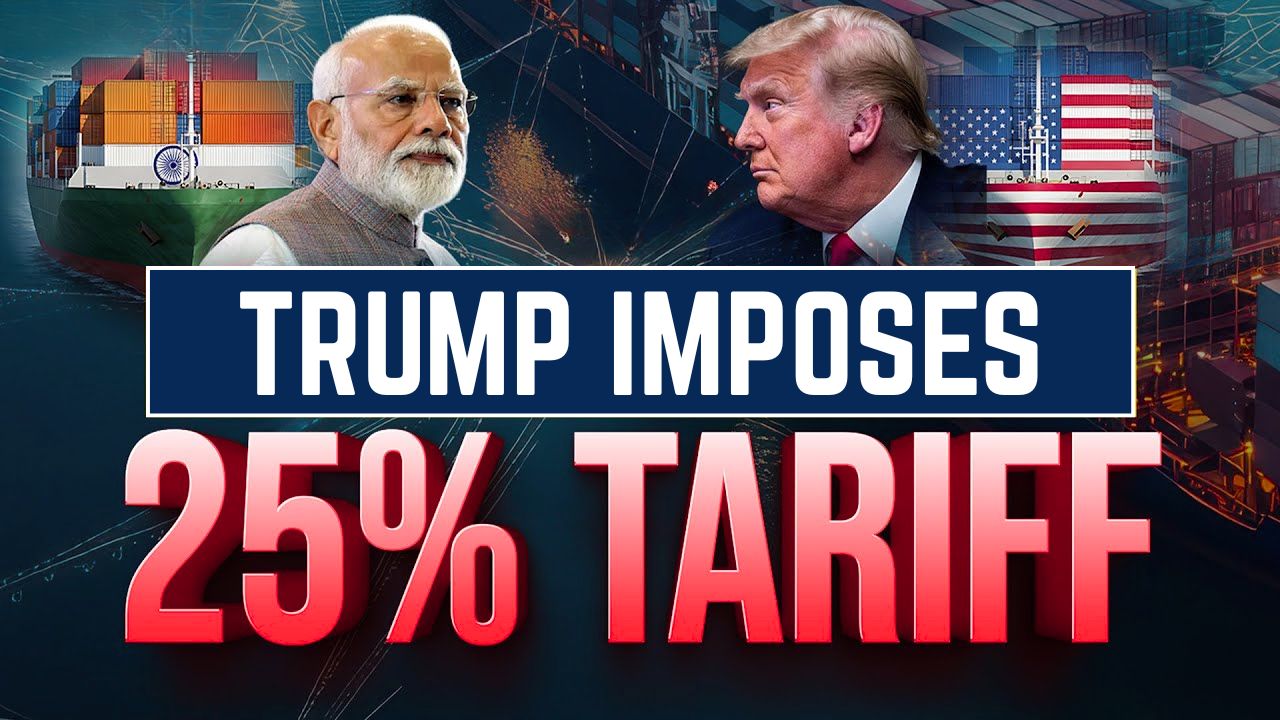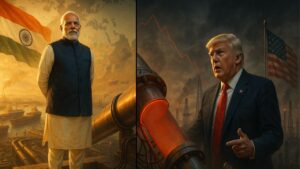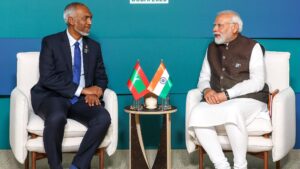I. The Clock is Ticking
On August 1, 2025, the clock doesn’t just strike a new day for Indian trade- it tolls a warning bell for the country’s export engine. In less than 24 hours, a new era of punitive US tariffs is set to slam into Indian goods, threatening to upend supply chains, slash revenues, and send shockwaves through MSME-dominated industries already walking a tightrope.
At the center of this economic tremor is a formal declaration from former U.S. President Donald Trump: a 25% tariff on Indian exports, citing “protectionist” policies and India’s continued engagement with Russia. But that’s only the beginning. Officials hint at further, unspecified penalties tied to defense and energy deals with Moscow – nudging the total cost burden beyond 30% when sectoral surcharges and BRICS-related tensions are tallied in.
Caught in the crossfire are India’s micro, small, and medium enterprises (MSMEs) – the backbone of export sectors like textiles, pharmaceuticals, electronics, and gems. With no final bilateral trade deal signed and diplomatic momentum stalling, these businesses are left dangling. Many U.S. buyers have already hit pause, freezing or cancelling purchase orders in anticipation of chaos at customs.
What’s unfolding is more than a trade dispute. It’s a slow-boiling economic standoff, one that demands sharper tactics, faster decisions, and a renewed focus on protecting the exporters who keep India’s trade wheels spinning.
II. The Tariff Bomb: What’s Changing on August 1
It’s not a warning anymore. It’s a policy. Starting August 1, a sweeping 25% tariff will blanket a wide range of Indian exports entering the U.S., a move that’s both economically jarring and politically loaded.
The announcement came straight from Donald Trump, returning to trade war form with a sharp jab at India’s “protectionist” tendencies. But this isn’t just about duties. There’s a shadow clause too: a murky, additional “penalty” tied to India’s ongoing energy and defense trade with Russia. The specifics remain deliberately vague leaving exporters in a haze of strategic guessing.
💣 The Real Cost? Over 30%
Analysts tracking the situation are blunt: when you layer in sector-specific surcharges, retaliation-linked fines, and BRICS-related penalties, the true burden could shoot well past 30%. That’s not just a fee – it’s a wall.
What’s Getting Hit
While the tariff is technically across-the-board, its sting will be sharpest in MSME-heavy sectors: textiles, electronics, pharmaceuticals, and gems, all industries where margins are already thin and global competition is fierce.
For Indian exporters, August 1 isn’t just a date – it’s a reckoning. The question isn’t if trade volumes will drop. It’s how fast and how far.
III. US Motivations: The Real Reasons Behind the Tariffs
To understand this latest flare-up in India – U.S. trade tensions, don’t just follow the money – follow the politics.
When former President Trump unveiled the 25% tariff hammer, it was draped in rhetoric about “fair trade” and India’s alleged “protectionist fortress.” But the deeper reasons, layered beneath campaign slogans and economic jargon, are more geopolitical than fiscal.
The Russia Factor: Energy, Arms, and Strategic Red Lines
Front and center is India’s continued oil and defense cooperation with Russia. Despite Western sanctions, India has ramped up discounted crude purchases from Moscow and continues key defense procurement ties moves that Washington views as undermining its broader containment strategy.
The so-called “unspecified penalties” in the tariff package are widely understood to be linked to this defiance. They’re not formally spelled out a tactical ambiguity that keeps leverage in U.S. hands while spooking Indian exporters into compliance.
The “Protectionism” Accusation
Trump’s trade team also revived a long-standing grievance: India’s historically cautious market policies. Whether it’s high tariffs on agricultural imports, restrictions on genetically modified crops, or stringent testing requirements for foreign goods, the U.S. has often framed India as a country that talks globalization but walks autarky.
For Washington, this is the moment to force concessions. And tariffs, once again, are the tool of choice.
The Election Undercurrent
Let’s not ignore the elephant in the Situation Room – the American election cycle. Flexing hardline trade credentials plays well with a protectionist-leaning base. Taking on India (while being tough on China) serves as proof of strength without the risks of engaging a true superpower.
In short, the tariffs may look like economic measures, but they’re being driven by geopolitical chess and domestic optics. For Indian exporters, that means they’re not just battling numbers, they’re navigating narratives.
IV. India’s Response: Negotiation, Not Capitulation
India isn’t folding. At least, not yet.
Faced with punitive tariffs and rising uncertainty, New Delhi has chosen negotiation over submission – pushing back against Washington’s pressure with a mix of strategic restraint and selective concession. While the U.S. has demanded immediate, sweeping access to Indian markets, India is sticking to its preferred game: play the long hand, phase the moves.
Tariff Staging: India’s Favorite Playbook
Unlike the U.S., which wants zero tariffs almost overnight, India advocates a “staged reduction” approach, similar to its recent deals with the UK and Australia. This allows sensitive sectors – like agriculture, dairy, and MSME-linked manufacturing time to adjust before being fully exposed to foreign competition.
U.S. officials aren’t buying it. They want access now, not ten years from now. That’s where the talks are stuck.
The Cheese in the Room: Agriculture & GM Foods
Among the biggest sticking points? American agricultural exports – particularly genetically modified (GM) crops and dairy products. India has long resisted their entry, citing food safety, sovereignty, and consumer preference. For Washington, that’s a trade barrier. For India, it’s non-negotiable – at least in the short term.
Tactical Concessions, Not Strategic Surrenders
India has dangled a few carrots – phased market access, targeted American purchases, and limited tariff rollbacks in certain sectors. But no sweeping new offers have been made, and with no final deal signed before August 1, the current reality is one of stalemate.
Still, there’s a signal beneath the silence: a U.S. delegation is set to visit New Delhi later in August, suggesting both sides are preparing for Round Two once the dust settles. For now, India’s message is clear: it won’t be rushed into a deal scripted in Washington.
V. Exporters on the Edge: Who’s Getting Hit
While policymakers duel over trade clauses and timelines, India’s exporters are already feeling the squeeze. And nowhere is that pain sharper than in the country’s vast ecosystem of MSMEs, the micro, small, and medium enterprises that quietly power over 40% of India’s exports.
🧵📦 MSMEs in the Crosshairs
The looming tariff spike is no longer an abstract threat – it’s translating into real-time disruptions. Across India’s industrial clusters, purchase orders are being frozen, shipments delayed, and payments withheld as American buyers brace for price volatility and customs complications.
Sectors hardest hit? Textiles, pharmaceuticals, electronics, and gems are all dominated by MSMEs, and all highly sensitive to even marginal cost fluctuations. These industries survive on tight margins and lean inventories. A sudden 25–30% spike in landed cost could obliterate their competitiveness overnight.
📉 Numbers Don’t Lie
Internal government estimates predict that if tariffs rise beyond 25%, up to 10% of India’s exports could be directly affected in the July–September quarter alone. That’s not a forecast, it’s a tremor that’s already visible in port data and buyer behavior.
For many small exporters, this isn’t about market share – it’s about survival. With payment cycles tightening and logistics pipelines freezing up, the fear is spreading that some MSMEs won’t make it to Q4.
🧭 The Psychological Fallout
Beyond spreadsheets and shipments, the uncertainty is creating a confidence crisis. Exporters are scaling back production. Warehouses are piling up with unsold inventory. And investor sentiment across trade-dependent regions from Surat to Noida is turning cautious.
In short: India’s exporters aren’t waiting for August 1 to feel the impact. They’re already bleeding and the worst may be yet to come.
VI. Fallout Forecast: Short-Term Shocks, Long-Term Shifts
The tariffs arriving on August 1 will not only rattle current trade flows but may also accelerate a deeper structural shift in global supply chains. The short-term pain for Indian exporters is severe, but the long-term risks are potentially more damaging.
Immediate Economic Disruptions
In the near term, the consequences are already visible. Export volumes are declining across tariff-affected sectors. MSMEs are cutting back on production as purchase orders remain suspended or canceled. Freight schedules are being reworked, and payment terms renegotiated. The uncertainty has created a pricing standoff between Indian suppliers and U.S. importers, with neither side willing to absorb the increased cost.
This disruption is more than a logistical challenge. It is a financial stress test for firms that operate with minimal buffers and high exposure to international demand cycles.
Strategic Relocation of Supply Chains
Perhaps more concerning is the risk of permanent erosion of India’s position in key export markets. American buyers are already exploring alternative suppliers in countries such as Vietnam, Indonesia, and Mexico, where tariff conditions are more favorable. This shift, once embedded, may not easily reverse, even if India and the U.S. reach a trade agreement later in the year.
India’s exporters face the possibility of losing both short-term revenue and long-term customer loyalty. For sectors like electronics and apparel, which rely on consistency and large-volume contracts, even temporary disengagement can trigger a shift in sourcing strategies.
Implications for Export Competitiveness
India’s export competitiveness has been hard-earned through decades of cost efficiency, labor-intensive manufacturing, and gradual infrastructure improvement. High tariffs risk undoing this progress by making Indian goods less attractive in terms of price and reliability.
There is also a reputational cost. Persistent uncertainty and unresolved trade tensions can signal instability to foreign investors and procurement managers. This weakens India’s position not only in the U.S. but across interconnected markets that follow U.S. policy signals.
VII. Tactical vs. Strategic: What India Needs to Do Now
India’s approach to the current tariff crisis has so far leaned on long-term diplomacy. The goal is a comprehensive trade agreement that aligns with broader economic objectives. However, as the immediate impact of tariffs begins to disrupt key export sectors, voices are growing louder for a more tactical, time-sensitive response.
Calls for Faster Action
Industry associations, export councils, and policy analysts are urging the government to move beyond broad negotiation frameworks. Many argue that India’s response must include short-term measures to support exporters who are already facing financial distress.
Suggestions include temporary export subsidies, emergency credit lines for MSMEs, and accelerated diversification of trade partners. The aim is to buffer the immediate shock while larger negotiations continue in parallel.
The Risk of Overplaying Patience
India has positioned itself as a patient and principled negotiator in international trade. This has earned it credibility in long-form diplomatic forums. But in the face of urgent economic pressure, patience alone may no longer be a viable strategy.
By the time a final deal is struck, many MSMEs may have already lost clients, contracts, or capacity. Timing now becomes a strategic variable, not just a diplomatic consideration.
Planning for Autumn Negotiations
Despite the August 1 setback, India is planning to resume formal trade discussions later in the year. A U.S. delegation is expected in New Delhi in late August. The focus will likely shift to building a more durable agreement that addresses not only tariffs but also structural trade issues, regulatory alignment, and digital commerce.
That agreement, however, will take time. In the interim, India’s exporters need actionable support. The gap between negotiation timelines and ground-level business realities is widening. Closing that gap must now be part of the national trade strategy.
VIII. Conclusion: The Tariff Era Begins (Again?)
August 1 is not just a date. It marks a reset in India–U.S. trade relations, one where tariffs, uncertainty, and geopolitical leverage have returned to the center of the equation. Unless a last-minute breakthrough is reached, Indian exports entering the U.S. will face a 25 percent tariff, with the possibility of additional penalties pushing that figure beyond 30 percent for key sectors.
For Indian exporters, particularly MSMEs, this is not a theoretical scenario. It is an unfolding economic shock that demands immediate and coordinated action. The sectors most affected textiles, pharmaceuticals, electronics, and gems are already seeing disruption in orders and cash flows. Without intervention, this pressure will deepen.
The situation underscores an urgent need for policymakers to bridge the gap between high-level negotiations and on-the-ground business realities. While long-term agreements remain important, the current crisis calls for faster, more tactical responses to avoid irreversible damage to export competitiveness.
Trade relationships are no longer defined solely by agreements on paper. They are shaped by how quickly a country can respond to disruption, protect its producers, and reposition itself in a shifting global landscape.
India now faces a clear choice. Adapt to this moment with agility and precision, or risk losing ground in global markets that may not wait for negotiations to catch up.
The U.S. has confirmed that the tariffs will take effect on August 1 with no further extensions. However, ongoing diplomatic talks may result in revisions or relief measures later, depending on the outcome of negotiations expected in the coming months.
Frequently Asked Questions (FAQ)
1. What tariffs are Indian exports to the U.S. facing from August 1, 2025?
A 25 percent tariff will apply to Indian goods entering the U.S. starting August 1. Additional penalties related to India’s trade with Russia may raise the total effective duty to over 30 percent in some industries.
2. Which export sectors are most vulnerable to these new tariffs?
Pharmaceuticals, textiles, gems and jewellery, auto parts, seafood, and chemicals are the most exposed. These sectors are dominated by MSMEs that depend heavily on the U.S. market and operate with limited financial buffers.
3. Could the tariffs still be delayed or reversed?
The U.S. has confirmed implementation from August 1 with no planned extensions. However, diplomatic negotiations are continuing. A visiting trade delegation later in August may open the door for revisions or partial relief.
4. Why might the U.S. impose additional penalties beyond the 25 percent tariff?
These penalties are tied to India’s ongoing energy and defense trade with Russia. The United States views these ties as misaligned with its geopolitical strategy and has included them as a factor in its broader trade response.
5. How are MSMEs in India coping, and what support is available to them?
MSMEs are already experiencing order cancellations, cash flow strain, and production slowdowns. Industry groups are calling for export credit support, targeted subsidies, and fast-track access to new international markets.




